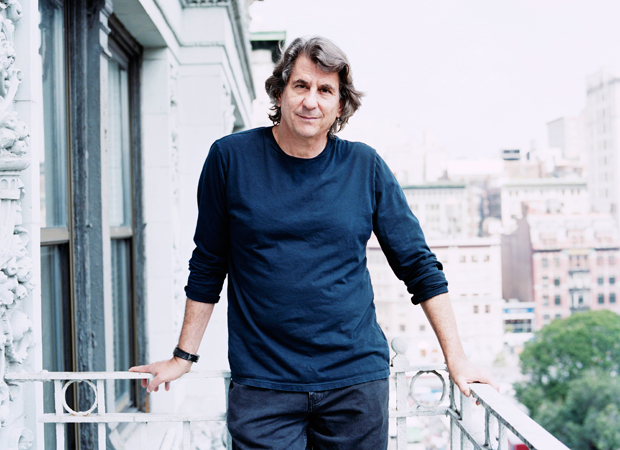
State of play: an interview with David Rockwell
The architect and designer talks to Andrea Klettner about designing hotels, hospitals and playgrounds
David Rockwell is founder and CEO of Rockwell Group, a multi-disciplinary architecture and design studio based in New York City. With an artistic background - his mother worked in the theatre - Rockwell enrolled at Syracuse University to study architecture, finishing his studies at the Architectural Association in London. His work ranges from hospitals to hotels, including the W New York and W Union Square. In 2009 and 2010 Rockwell Group was responsible for the set design of the Academy Awards in Los Angeles and the practice also renovated the home of the ceremony, the Kodak Theatre. The Group was also responsible for the entrance installation to the 2008 11th annual Venice Architecture Biennale.
Q: Which building or project of your own design do you consider the most interesting and why?
Because our projects are so diverse, and bring up such different challenges and rewards, it’s hard to name one project. One of the projects I am most proud of is Imagination Playground. It was the result of over five years of research, development, focus groups and testing – all to try to figure out the best environment and tools to encourage unstructured, child-directed free play, which I felt was missing in traditional American playgrounds. What we came up with was Imagination Playground, an interactive, transformable environment that inspires children to manipulate their environment and create a playspace of their own with sand, water, and custom designed loose parts such as wagons, carts and bright blue biodegradable foam blocks.
Q: How did you approach this project?
It all started when I began spending time in playgrounds with my two children and noticed a lack of encouragement of imagination, creativity and variation. The wheels began to turn just after a few public projects I had collaborated on with New York City, and so I immediately turned to the City to partner with them on a pro-bono playground initiative in Lower Manhattan. During the last five years, we consulted with all sorts of seminal figures in the field of play and education, not to mention parents, teachers, and kids.
Q: Is this typical of how you work?
Imagination Playground was a pro-bono project that we initiated. But whether the client comes to us or we seek out a specific project, we decide to take them on on a case-by-case basis, not at all dependent on project type, location, size, or client. Once we begin a project, we try to have a fresh perspective, and focus on the particular history and context of the client and location. Our first steps always include collaborative brainstorming amongst a group of the 140 designers in my firm, who are also artists, sculptors, chefs, opera singers, architects, playwrights, and set designers. With every new project and combination of people, new ideas, vocabularies, materials, techniques and designs emerge.
Q: Good design is many things, what elements do you feel underpin good design?
In our work at Rockwell Group we want the guests to connect to our projects visually, but our overarching goal is to create spaces that engage all the senses, and encourage connections to the environment and between the people within those environments. So we consider it a success if these experiences are powerful and lasting, whether watching a play, sitting in a hotel lobby, enjoying a meal, or seeing an exhibit.
Q: Which one aspect of design do you give the highest priority?
We spent a lot of time envisioning how people might feel as they move through our environments, how we mark and celebrate an entry, how we choreograph a promenade through spaces, and how we define and enliven transitions. We use countless devices, techniques, effects and materials to craft interiors that resonate with people.
Q: How has your approach to architecture design changed over the years?
Our work has become more diverse, mostly because I never want to stop expanding and exploring new project types and hybrids! We started primarily designing restaurants and other hospitality projects and over the past 25 years we have taken on new and different project types, including children’s hospitals, museums, theatres, set designs, playgrounds and art installations. We are so lucky to have incredibly interesting projects which allow us to constantly evolve, change and push the boundaries of our design practice.
Q: What do you feel are the greatest challenges for today’s architects?
There is definitely less money being spent on design and construction right now which has resulted in fewer projects. On the flip side, I see an opportunity for more temporary installations and structures, as opposed to only permanent solutions. There will always be a need for traditional building schemes, but I think that developers and architects are starting to think about alternatives to the traditional building and are asking themselves, “do we need to build here?” and “can we solve this problem by repurposing the space or doing something temporary?”
Q: What next for Rockwell Group?
At Rockwell Group, we’re doing a lot of R&D into ways we can deliver impact without always reverting to bricks and mortar. We have our own in-house research facility called the LAB at Rockwell Group which works on inventing and exploring new interactive technology so that our projects are constantly fresh and reactive. Technology is going to continue to pervade every aspect of our lives, and I think we have to not only accept that, but celebrate it, and make it work alongside the hand-crafted and the tried-and-true.
Q: What big projects do you have coming up?
We're doing the W hotel in Paris, our first one for the chain in Europe. We're also working on a resort in Chengdu, China and we're designing a portable cooking school for Jamie Oliver to travel around the United States.
David Rockwell, thank you.